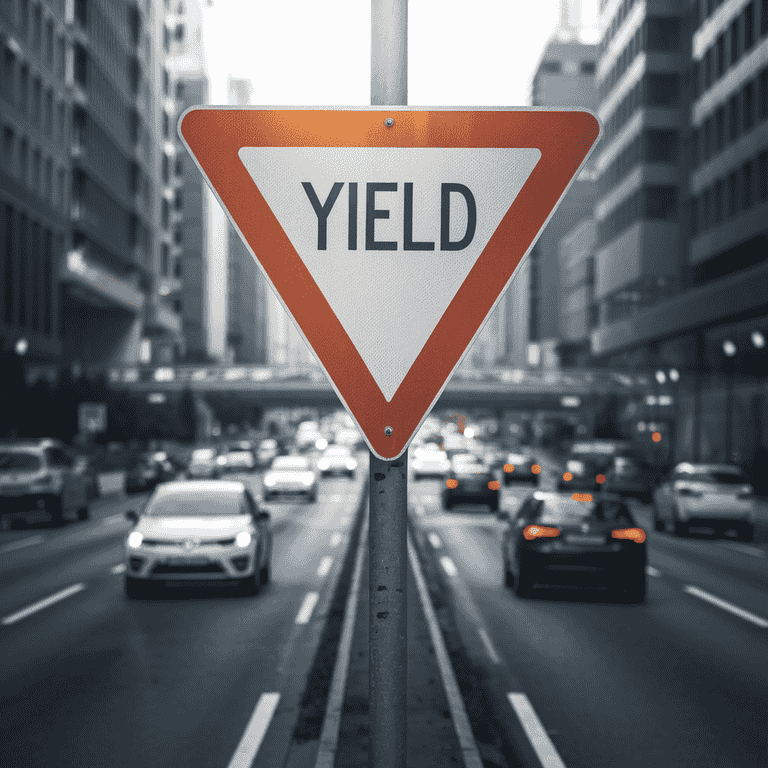What is Failing to Yield?
Definition of Failing to Yield
“Failing to yield” refers to a driver’s failure to give the right of way to other vehicles or pedestrians when required by law. Yielding is an important part of safe driving, as it helps avoid collisions and promotes smooth traffic flow.
Drivers are expected to yield in certain situations, especially where signs or road markings indicate the need to let others go first. Failing to yield can lead to accidents, legal penalties, and financial consequences.

Yielding Laws and Rules
Yielding rules are established to help drivers anticipate who has the right of way. Here are some basic yielding laws commonly followed:
- Yielding at intersections: Drivers must yield to oncoming traffic when making a left turn at an intersection without a traffic signal.
- Four-way stops: At intersections with four-way stop signs, the driver who arrives first has the right of way. If multiple drivers arrive simultaneously, the driver on the right goes first.
- Traffic circles and roundabouts: Drivers entering a roundabout must yield to traffic already in the circle.
- Pedestrian crosswalks: Drivers must yield to pedestrians crossing the road at marked or unmarked crosswalks.
These rules can vary slightly depending on local laws, but the general purpose is to keep everyone safe and prevent misunderstandings on the road.
Common Situations Involving Failing to Yield
Failing to yield can occur in several everyday situations:
Left Turns at Intersections
When turning left, drivers must yield to oncoming traffic unless they have a green arrow or other signal indicating the right of way. Ignoring this can cause serious T-bone collisions.
Yielding to Emergency Vehicles
By law, drivers must pull over and yield when emergency vehicles (like ambulances, fire trucks, and police cars) approach with flashing lights or sirens. Disregarding this can lead to steep penalties.
Yielding to Pedestrians at Crosswalks
Pedestrians have the right of way in both marked and some unmarked crosswalks. Failing to yield to a pedestrian in a crosswalk is a common cause of tickets and accidents.
Merging and Lane Changes
When merging onto highways or changing lanes, drivers must yield to cars already in the lane they are entering. Accidents often happen when drivers fail to check their blind spots or attempt to merge too aggressively.

Legal Consequences of Failing to Yield
Traffic Citations and Penalties
Failing to yield can lead to a range of penalties, including fines and points on a driver’s license. The exact penalty depends on the severity of the violation and state laws.
| Penalty Type | Description |
|---|---|
| Fines | Drivers may be fined a set amount, which varies by state and local regulations. Fines are often higher in cases involving injuries. |
| License Points | Failing to yield may result in demerit points added to a driver’s license. Accumulating too many points can lead to license suspension. |
| Traffic School | In some cases, drivers may be ordered to attend traffic school to reduce points on their record. This is often an option for first-time offenders. |
Criminal Charges for Failing to Yield
In some cases, failing to yield can result in criminal charges, especially if it leads to an accident involving serious injury or death. Here are some instances where criminal charges may apply:
- Reckless driving: When a failure to yield shows a blatant disregard for road safety, it may be classified as reckless driving, which can lead to fines, license suspension, and even jail time.
- Vehicular manslaughter: In tragic cases where failing to yield results in a fatal accident, the driver may face charges of vehicular manslaughter.
These charges are more severe than standard traffic citations and can have long-term effects on a person’s record and freedom.
Consequences for Repeat Offenders
For drivers who repeatedly fail to yield, the consequences can become increasingly serious.
- Increased Fines: Repeat violations typically lead to higher fines and additional court fees.
- License Suspension: A history of failing to yield can lead to temporary or permanent suspension of a driver’s license, especially if combined with other traffic violations.
- Mandatory Defensive Driving Courses: In some states, repeat offenders must complete defensive driving courses to regain their license.
Impact on Auto Insurance Rates
Auto insurance companies view failing to yield violations as indicators of risky driving behavior. A citation for failing to yield often results in higher insurance premiums. Here’s how it generally affects insurance:
- Rate Increases: Even a single failure-to-yield violation can cause insurance premiums to go up, as insurers view it as a higher risk for accidents.
- Loss of Good Driver Discounts: Some companies offer discounts for clean driving records. A failure-to-yield violation may lead to the loss of this benefit.
Each insurance company has its own policies, but traffic violations, especially those involving a failure to yield, often result in increased rates for several years.
Failing to Yield and Accidents
Common Types of Accidents Resulting from Failing to Yield
Failing to yield can lead to various types of accidents, many of which can be severe. Here are some common scenarios where this violation occurs:
T-bone collisions: These happen when a vehicle fails to yield while making a left turn and is struck by oncoming traffic. T-bone accidents often result in significant injuries.
Rear-end accidents: A driver might not yield to a pedestrian or another vehicle and suddenly stop, causing a rear-end collision. These crashes can lead to whiplash and other injuries.
Intersection accidents: Vehicles colliding at intersections are common when drivers neglect to yield to traffic with the right of way. These accidents can be particularly dangerous, especially at high speeds.
Pedestrian accidents: Failing to yield to pedestrians can result in serious injuries or fatalities. It’s essential for drivers to remain vigilant and aware of crosswalks.
Understanding these types of accidents highlights the importance of yielding correctly. Every driver plays a role in ensuring safety on the road.
Consequences of Accidents Caused by Failing to Yield
The consequences of accidents resulting from failing to yield can be severe, affecting everyone involved. Here’s what can happen:
Injuries: Victims of such accidents can suffer from a range of injuries, from minor cuts and bruises to life-altering conditions like spinal injuries or traumatic brain injuries.
Legal liability: The driver who fails to yield may be held liable for damages, including medical expenses, property damage, and lost wages. This can lead to costly lawsuits.
Increased insurance rates: Being found at fault in an accident can lead to higher insurance premiums. Insurance companies view these incidents as indicators of risky behavior.
Emotional trauma: Accidents can leave lasting emotional scars on both victims and at-fault drivers. Anxiety and post-traumatic stress disorder are common after serious crashes.
Understanding these consequences reinforces the need for responsible driving. Every time you get behind the wheel, it’s essential to prioritize safety.

How to Avoid Failing to Yield
Practical Tips for Drivers
Preventing incidents related to failing to yield is possible with careful driving. Here are some practical tips to help:
Always check for signs: Pay attention to yield signs and traffic signals. Knowing when to yield can prevent accidents.
Look both ways: Before entering intersections or crosswalks, always look left and right. This simple action can save lives.
Use turn signals: Communicating your intentions to other drivers helps everyone on the road anticipate your actions. Turn signals are not just a courtesy; they’re a safety necessity.
Watch for pedestrians: Be extra cautious in areas with heavy foot traffic. Always be prepared to stop for pedestrians, even if you have the right of way.
Adjust your speed: Slowing down in unfamiliar areas or when approaching intersections gives you more time to react to other drivers and pedestrians.
Importance of Defensive Driving
Defensive driving is a vital approach to road safety. Here’s why it matters:
Awareness: Defensive driving encourages drivers to stay alert and aware of their surroundings. This heightened awareness can prevent accidents.
Anticipating hazards: By anticipating potential hazards, you can make safer decisions on the road. This includes being ready to yield when necessary.
Improving reaction times: Defensive driving techniques improve your ability to react quickly and effectively to unexpected situations.
Lowering risks: Adopting defensive driving habits significantly reduces the likelihood of being involved in a failing to yield incident or any other type of accident.
Taking a Defensive Driving Course
Thinking about a defensive driving course can be a wise decision. Here’s why:
Skill enhancement: These courses teach valuable driving skills that help you navigate various road situations safely.
Insurance benefits: Many insurers offer discounts for completing a defensive driving course, which can help offset costs.
Point reduction: If you’ve received a ticket for failing to yield, completing a defensive driving course may help reduce points on your driving record.
Greater confidence: Knowledge gained from these courses can increase your confidence behind the wheel, allowing you to drive more safely.
By implementing these tips and considering defensive driving courses, you can help create a safer driving environment for yourself and others. The road is shared by everyone, and responsible driving makes a significant difference.
What to Do After Receiving a Failing to Yield Citation
Receiving a citation for failing to yield can be stressful. Knowing what steps to take next can help you navigate the situation smoothly.
Understand the Citation
The first step is to understand the citation itself. Here’s what you should know:
Read the citation carefully: The citation will include details such as the date, time, and location of the alleged violation, along with the specific law you are accused of breaking.
Know your rights: You have the right to contest the citation in court if you believe it was issued unfairly. This process can help you avoid fines or points on your driving record.
Pay attention to deadlines: Citations usually come with a deadline for responding or paying the fine. Missing this deadline can lead to additional penalties.
Gather Evidence
If you decide to contest the citation, gathering evidence is essential. Here are some helpful steps:
Document the scene: Take photos of the location where you received the citation. Include signs, traffic signals, and road conditions that may support your case.
Collect witness statements: If there were witnesses to the incident, ask for their contact information. Their statements can help strengthen your argument.
Review your driving record: A clean driving record can work in your favor. If you have a history of safe driving, present this information when contesting the citation.
Consider Legal Help
In some situations, seeking legal help can be beneficial. Here’s why you might want to explore this option:
Expert advice: An attorney who specializes in traffic violations can offer valuable insights and strategies for contesting your citation.
Navigating the legal system: Legal processes can be complex. An attorney can guide you through the steps and represent you in court if needed.
Potential for reduced penalties: If you are found guilty, an attorney might be able to negotiate for reduced penalties, such as lower fines or fewer points on your record.
Penalties for Failing to Yield
Failing to yield can lead to various penalties, which can vary by state. Here are some common consequences you might face:
Fines: Typically, a citation for failing to yield includes a monetary fine. The amount can vary depending on the jurisdiction.
Points on your driving record: Many states assign points for traffic violations. Accumulating too many points can lead to higher insurance rates or even a suspended license.
Traffic school: In some cases, you may have the option to attend traffic school to avoid points on your record. Completing this course can also reduce fines.
Increased insurance premiums: Having a citation on your record can result in higher insurance rates. Insurance companies may view this as a sign of risky behavior.
Understanding these penalties can help you make informed decisions after receiving a citation.

Breaking It Down for You
Failing to yield is a serious traffic violation that can lead to accidents and legal consequences. By understanding what it means, recognizing the potential repercussions, and knowing what to do after receiving a citation, you can better navigate this challenging situation.
Always prioritize safety on the road. Yielding when required is not just about following the law; it’s about protecting yourself and others. If you find yourself facing a citation, take the time to understand your rights and options. With the right approach, you can manage the aftermath of a failing to yield citation effectively.

Frequently Asked Questions
What does “failing to yield” mean in traffic laws?
Failing to yield means that a driver does not give the right of way to another vehicle or pedestrian when required by law. This typically occurs at intersections, when merging onto a roadway, or at crosswalks.
What are some common situations where drivers fail to yield?
Common situations include not yielding at stop signs, ignoring traffic signals, failing to yield when merging onto a highway, and not yielding to pedestrians at crosswalks.
How can I contest a failing to yield citation?
To contest a citation, you can request a court hearing where you will present your evidence and argue your case. It’s often helpful to gather witness statements and any documentation that supports your argument.
Can I fight a failing to yield citation if I have a clean driving record?
Yes, having a clean driving record can support your case. It demonstrates responsible driving behavior, which may influence the judge’s decision or the prosecutor’s willingness to negotiate.
What are the long-term effects of a failing to yield citation?
The long-term effects can include increased insurance premiums, points on your driving record that may affect your ability to drive legally, and a potential impact on future driving privileges.
What should I do if I believe the citation was issued in error?
If you believe the citation was issued in error, gather any evidence that supports your claim. This includes photos, witness statements, or any other relevant information. You can then contest the citation in court.
Will attending traffic school help if I receive a failing to yield citation?
Yes, attending traffic school may help. In some jurisdictions, completing a traffic school course can prevent points from being added to your driving record and may reduce your fine.
How can I improve my understanding of traffic laws to avoid future violations?
You can improve your understanding of traffic laws by studying your state’s driving manual, taking defensive driving courses, and staying updated on changes in traffic regulations.
What is the difference between a moving violation and a non-moving violation?
A moving violation occurs when a driver breaks a traffic law while the vehicle is in motion, such as speeding or failing to yield. A non-moving violation usually involves issues that do not occur while the vehicle is moving, like parking violations.
Is it possible to negotiate the penalties associated with a failing to yield citation?
Yes, it is possible to negotiate penalties, especially if you have a clean driving record or if mitigating circumstances are present. An attorney can assist with negotiations to potentially reduce fines or points.
What role does the police report play in a failing to yield citation?
The police report provides an official account of the incident, including details such as the time, location, and conditions at the time of the violation. This document can be crucial if you contest the citation, as it may contain evidence or statements from officers.

Glossary
Accident: An unintentional event that results in damage or injury, often involving vehicles on the road.
Citation: A legal notice issued by law enforcement to a driver for violating a traffic law.
Crosswalk: A designated area on the road for pedestrians to cross, often marked with lines or signals.
Defensive Driving: A driving technique focused on safety that encourages drivers to anticipate potential hazards and react appropriately.
Driving Record: A comprehensive history of an individual’s driving behavior, including violations, accidents, and license status.
Failure to Yield: A traffic violation that occurs when a driver does not give the right of way as required by law.
Insurance Premium: The amount paid for an insurance policy, often influenced by a driver’s record and claims history.
Intersection: The area where two or more roads meet, often requiring drivers to yield or stop.
Mitigating Circumstances: Factors that may lessen the severity of a violation or offense, potentially impacting penalties or judgments.
Moving Violation: A traffic violation that occurs while a vehicle is in motion, such as speeding or failing to yield.
Non-Moving Violation: A traffic violation that occurs when the vehicle is not in motion, such as parking violations.
Pedestrian: A person who is walking, particularly in areas designated for pedestrian traffic.
Right of Way: The legal right to proceed first in traffic, typically given to certain vehicles or pedestrians based on traffic laws.
Traffic School: An educational program designed to improve driving skills and knowledge of traffic laws, often used to mitigate penalties for violations.
Traffic Violation: Any breach of traffic laws, which can include both moving and non-moving violations.
Witness Statement: A written or verbal account provided by someone who observed the incident, which can be used as evidence in legal proceedings.

Additional Resources for You
Our lead attorney, Molly Rosenblum, Esq., has created various resources to support you in your time of need. Here are some valuable resources:
Criminal Defense Attorneys: Understand how a defense attorney can help you navigate through your criminal case.
Felonies in Nevada: Get informed about the different types of felonies in Nevada and their potential legal consequences.
Attorneys Answer Your Questions About Miranda Rights: Have your questions about Miranda Rights addressed by legal professionals.
Firearms Defense Lawyers: Learn how a defense lawyer can assist you in a firearm-related case.
Theft Defense Lawyers: Discover how a defense lawyer can help you in theft-related legal concerns.
Winning Felony Cases in Nevada: Gain insights into how felony cases are won in Nevada.
Drug Possession Defense Lawyer: Learn about the strategies that a defense lawyer can use in drug possession cases.
Marijuana Possession Questions? We’ve Got Answers.: Get answers to your questions about marijuana possession laws in Nevada.
Juvenile Defense Lawyers: Understand how a defense lawyer can help in cases involving juvenile charges.
Juvenile Charges: Get Legal Advice: Seek legal advice regarding juvenile charges.
Charged with Solicitation? We Can Help.: Find out how we can assist if you are charged with solicitation.
Nevada Traffic Tickets: Learn how we can help with traffic tickets in Nevada.

A Special Message from Our Lead Attorney

Molly Rosenblum
Dear Reader,
Thank you for taking the time to read through our resources on traffic tickets. Navigating through traffic violations can be challenging, and we’re here to help you every step of the way.
At the Rosenblum Allen Law Firm, we’re committed to providing you with the guidance and representation you need. With our extensive experience and knowledge, we’re ready to help you understand the nuances of your situation and explore the best options moving forward.
Every case is unique, and we believe in providing personalized attention to each client. I invite you to call me and my team at (702) 433-2889. Let’s get the ball rolling and work together on your situation.
I look forward to hearing from you soon.
Warm Regards,
Molly Rosenblum, Esq.



